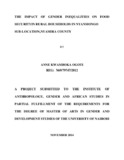| dc.description.abstract | The study examined the impact of gender inequalities on food security in rural households in
Nyansiongo Sub
-
Location, Nyamira County. The research sought answers to the following
questions:
One, what resources do women in Nyansiongo Sub
-
Location access a
nd control to
ensure household food security? Two, what are the attitudes and perceptions of women in
Nyansiongo Sub
-
Location to ensure food security in their households? Three, what is the level
of participation in decision making by the women in Nyansi
ongo Sub
-
Location to ensure food
security in their households?
The main objective of the study was to
investigate the impact of gender inequalities on food
security in rural households of Nyansiongo Sub
-
Location in Nyamira County. The three
objectives of
the study were as follows: one, to examine women access and control of the
resources necessary to ensure food security in households in Nyansiongo Sub
-
Location.
Second, analyse the attitudes and perceptions of women in Nyansiongo Sub
-
Location towards
foo
d security in their households. Third, investigate the level of participation in decision
making by women in Nyansiongo Sub
-
Location to ensure food security in their households.
The study was guided by the Entitlement Approach/Theory. This theory is bas
ed on
three
conceptual categories: One, the endowment set, two, the entitlement set, and, three, the
entitlement mapping (e
-
mapping) rural households in Nyansiong
o Sub
-
Location, Nyamira County. A sample of 60 respondents
was used in the study. The study elements were selected using the simple random sampling
method. Data was collected using structured interviews, focus group discussions, key informant
interviews
, observation and secondary sources. Quantitative data was analyzed using the
Statistical Package of Social Science (SPSS
-
18) computer programme whilst qualitative data
was analyzed according to emerging themes of content analysis.
The main findings of t
he study were, one, the resources necessary for household food
production, mainly land, oxen and plough, and farm equipment and implements were controlled
by the husband or the father in
-
law, two, the household income was also controlled by the
husband, t
hree, the woman did not participate in decision making on household food security.
Another findings were that the woman was the major labour provider for household food
security.
It is therefore recommended that the woman should have control of the nece
ssary resources like
land and equipment to facilitate food security in the households. The woman should access and
control the household income so as to provide for adequate food for the household members.
She should also participate in decision making i
ssues in food security issues in the household.
The husband should provide the much needed labour in the production, harvest, preparation,
preservation and storage of food in the household to ensure household food security | en_US |

